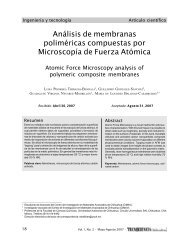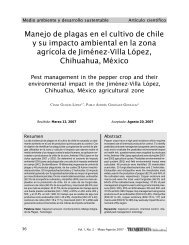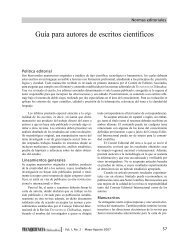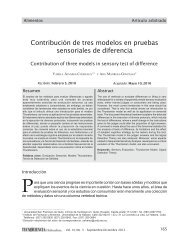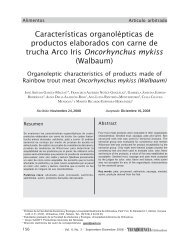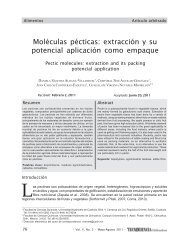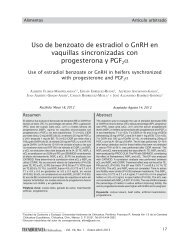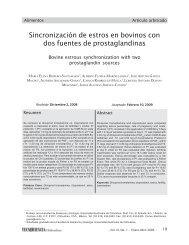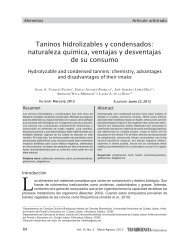Fabricación de un detector de N2O a base de un polímero conductor
Fabricación de un detector de N2O a base de un polímero conductor
Fabricación de un detector de N2O a base de un polímero conductor
- No tags were found...
Create successful ePaper yourself
Turn your PDF publications into a flip-book with our unique Google optimized e-Paper software.
LUISA YOLANDA QUIÑONES-MONTENEGRO, EDUARDO HERRERA-PERAZA Y LAURA ORTEGA-CHÁVEZ: <strong>Fabricación</strong> <strong>de</strong> <strong>un</strong> <strong>de</strong>tector <strong>de</strong>N 2 O a <strong>base</strong> <strong>de</strong> <strong>un</strong> <strong>polímero</strong> <strong>conductor</strong>se observa que el aumento <strong>de</strong> la misma estárelacionado directamente con la concentración<strong>de</strong> gas suministrado a <strong>un</strong>a temperatura ypresión constante. Se han reportado cambiossemejantes en la resistencia <strong>de</strong> material cuandoéste ha sido expuesto a otros gases, como porejemplo el NO 2(Agbor et al., 1995) en don<strong>de</strong> laresistencia disminuye con respecto al aumento<strong>de</strong> la concentración <strong>de</strong>l gas.Elizal<strong>de</strong> et al. (2008) mencionan que cadaestado redox <strong>de</strong> la polianilina está asociado con<strong>un</strong>a estructura electrónica específica y que elproceso <strong>de</strong> absorción <strong>de</strong> diferentes moléculaspue<strong>de</strong> <strong>de</strong>tectarse por sus cambios en laresistencia y/o conductividad eléctricas, y que<strong>de</strong>bido a la alteración <strong>de</strong> la estructura química,resulta muy difícil para el PANI volver a su estadooriginal. Por su parte, Yan et al. (2006) señalanque si la interacción <strong>de</strong>l gas con el <strong>polímero</strong>produce únicamente <strong>un</strong>a adsorción y no <strong>un</strong>aabsorción, el enlace pue<strong>de</strong> ser disociado con elaumento <strong>de</strong> temperatura <strong>de</strong>l sistema. Deacuerdo con esta última afirmación, se <strong>de</strong>mostró<strong>de</strong> forma experimental la recuperación <strong>de</strong> laspropieda<strong>de</strong>s eléctricas <strong>de</strong>l dispositivo <strong>de</strong>spués<strong>de</strong> haber sido expuesto a altas temperaturas. LaFigura 9 muestra la reversibilidad <strong>de</strong>l proceso <strong>de</strong>adsorción por parte <strong>de</strong> la película <strong>de</strong> PANI<strong>de</strong>spués <strong>de</strong> haber adsorbido las moléculas <strong>de</strong>N 2O y variar la temperatura <strong>de</strong>l sistema, lo quenos <strong>de</strong>muestra la posibilidad <strong>de</strong> utilizar eldispositivo en más <strong>de</strong> <strong>un</strong>a medición.Figura 9. Gráfico Nyquist concentraciones N 2O 100% a diferentestemperaturas.ConclusionesLa polianilina pue<strong>de</strong> ser utilizada como <strong>un</strong>sensor <strong>de</strong> gas basado en el cambio <strong>de</strong> suspropieda<strong>de</strong>s eléctricas; el PANI pue<strong>de</strong> sermanipulado eléctricamente y alterar así suscambios químico-resistivos ante la presencia<strong>de</strong> <strong>un</strong> agente externo. La adsorción que seprodujo por la interacción <strong>de</strong> ambos materialesrepresenta <strong>un</strong> cambio físico en la superficie <strong>de</strong>l<strong>polímero</strong>, y se obtuvo que este enlace pue<strong>de</strong>ser disociado con <strong>un</strong> aumento <strong>de</strong> temperatura,teniendo como resultado <strong>un</strong> dispositivo quepue<strong>de</strong> ser reutilizado <strong>de</strong> manera eficiente.Literatura CitadaAGBOR, N. E., and M. C. Petty. 1995. Polyaniline thin-films for gassensing,Sens. Actuators B: Chem. 28: 173-179ANDERSON, I. C., and J. S. Levine. 1986. «Relative Rates of NitricOxi<strong>de</strong> and Nitrous Oxi<strong>de</strong> Production by Nitrifiers, Denitrifiers,and Nitrate Respirers. Applied and EnvironmentalMicrobiology 51 (5) (May 1): 938–945.ABDELLAH, A., B. Fabel, P. Lugli, and G. Scarpa. 2010. SprayDeposition of Organic Semiconducting Thin-films: Towardsthe Fabrication of Arbitrary Shaped Organic ElectronicDevices. Organic Electronics 11 (6) (J<strong>un</strong>e): 1031–1038.BOND, A.M., S. Fletcher, F. Marken, S. J. Shaw, and P. G. Symons.1996. «Electrochemical and X-ray Diffraction Study of theRedox Cycling of Nanocrystals of 7,7,8,8-tetracyanoquinodimethane.Observation of a Solid–solid PhaseTransformation Controlled by Nucleation and Growth.» Journalof the Chemical Society, Faraday Transactions 92 (20)(January 1): 3925–3933.FATMANUR, K. F., A. Ayse Onen, N. Niyazi Bacak, and Y. Yagci.2002. Photoinitiated cationic polymerization using a novelphenacyl anilinium salt. Polymer: 2575-2579FREUND, M. S., A. Brajter-Toth, and M. D. Ward. 1990.Electrochemical and Quartz Crystal Microbalance Evi<strong>de</strong>ncefor Mediation and Direct Electrochemical Reactions of SmallMolecules at Tetrathiafulvalene-te. Journal of ElectroanalyticalChemistry and Interfacial Electrochemistry 289 (1–2) (August24): 127–141.HAYON, E., J. McGarvey. 1967. Flash photolysis in the vacuumultraviolet region of SO 42", CO 32and OH » ions in aqueoussolutions. J. Phys. Chem. 71:1472–1477JANATA, M. Josowicz, P. Vanysek, and D.M. DeVaney. 1998.Chemical Sensors. Analytical Chemistry pp. 70- 179.ELIZALDE-TORRES, J., H. Hu, A. Gua<strong>de</strong>rrama-Santana, A. García-Valenzuela and J.M. Saniger. 2008. Comparison of NO 2andNH 3gas adsorption on Semi<strong>conductor</strong> polyaniline Thin Films.Revista Mexicana <strong>de</strong> Física 54 (5): 358-36.NATTA, G., and G. Mazzanti. 1960. «Organometallic Complexes asCatalysts in Ionic Polymerizations.» Tetrahedron 8 (1–2): 86–100.PALANIAPPAN, S. and C. A. Amarnath 2006. A novel polyaniline–maleicacid–do<strong>de</strong>cylhydrogensulfate salt: Soluble polyanilinepow<strong>de</strong>r, React F<strong>un</strong>ct Polym 66: 1741–1748.30• Vol. VII, No. 1 • Enero-Abril 2013 •



